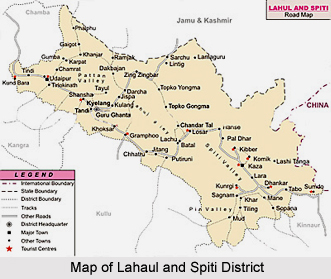Lahaul and Spiti District is one of the biggest districts of Himachal Pradesh with its headquarters at Keylong. This district is having an international boundary with Tibet. The valleys, mountains, glaciers, rivers, forests, pastures, and monasteries and ancient buildings of the former ruling dynasty are the principal objects to be explored in Lahaul and Spiti District. The entire district is full of natural scenery to explore.
History of Lahaul and Spiti District
As is clear from the name `Lahaul and Spiti`, the district comprises two different mountains tracts, one known as Lahaul and the other as Spiti. Hence the name of the district came into being with the formation of these two parts into a revenue district. The names, Lahaul and Spiti, have different origins. In ancient Buddhist scriptures, there is mention of a country named Khasa or Hasha to the south of Ladakh and Zanskar. Between the 6th century BC and the 5th century A.D., the Saka and Khasa tribes, after having been driven out from Central Asia by the Huns, came to India. Many of them settled down in the valleys of mid-Himalayas between Garhwal and Ladakh. This is borne out by the numerous remains of their graves found in these valleys. . It attained the status of a district in the year 1960.
 Geography of Lahaul and Spiti District
Geography of Lahaul and Spiti District
The valley of Lahaul is situated to the south of Ladakh. For this very reason this place derived its name "Lho-Yul" meaning `Southern Country`. To its south is situated the beautiful valley of Kullu across the Rohtang Pass (3195 metres) and the Bara Bangahal (Kangra) across the "Asakh" pass (5051 metres). Its western boundaries touch Pangi and Churah areas of Chamba District. To its north situated are the valleys of Zanskar and Ladakh across Shingola (5090 metres) and Baralacha la (5450 metres) respectively. Its eastern and south eastern boundaries coincide with those of Spiti and Western Tibet across the Kunzom Pass (4500 metres). Since the valley is situated in rain shadow area, north of the Pir Panjal ranges, the weather remains pleasant and quite comfortable during summer season that is from May to mid October. This is the best season to visit this valley. It seldom rains, and the Mercury level does not exceed 30 degree Celsius and never falls below 15 degree Celsius throughout the period. One can always enjoy bright sunshine wandering within lush green valley. There is little or no rain in monsoons. The climate remains dry and invigorating. The days are hot and nights are extremely cold. During winter season that is from November to April it snows heavily because of western disturbances and the temperature goes down below minus. There is an average annual snow fall of about 7 feet.
Culture of Lahaul and Spiti District
The customs, myths, beliefs and conventions of the simple people are the unique features of this border highland. Every village or a hamlet has a prayer flag fluttering over the Buddhist monastery. These shrines are the centres of the cultural life of the people that have influenced their religious beliefs for centuries and round which their social life revolves.
Tourism in Lahaul and Spiti District
Tourism in Lahaul and Spiti District offers the travellers to explore its museums, art galleries and forts. The scenic beauty of the surrounding nature adds charm to the tourism experience in Lahaul and Spiti District. Keylong Museum, Pin Valley National Park, Suraj Taal, Chandra Taal, Rohtang Pass, Trilokinath Temple, Markula Devi Temple, Kunzam Pass and Kye Monastery are some of the main attractions of this district. All these sites are worth exploring.






